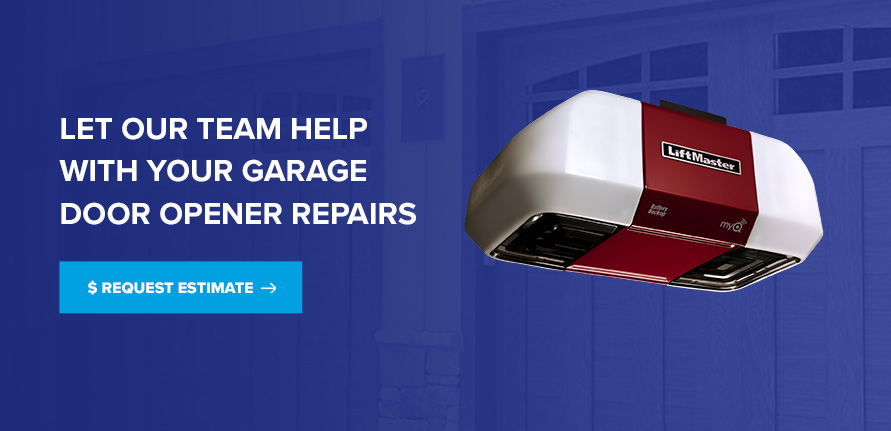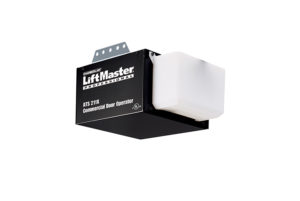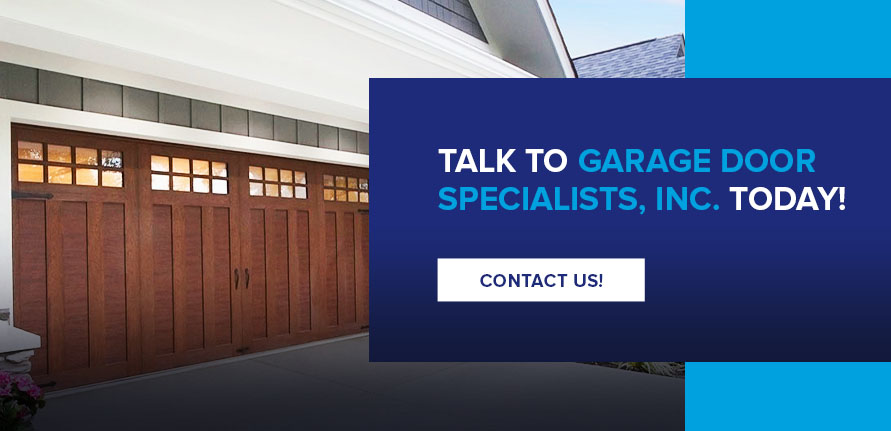Decoding LiftMaster® Blink Codes
Decoding LiftMaster® Blink Codes
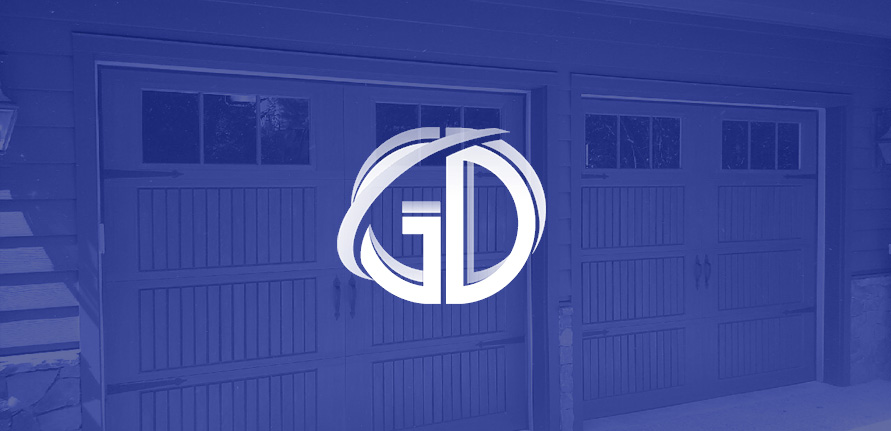
LiftMaster garage door openers use blink codes to communicate error messages. These codes can help you identify issues without needing specialized tools. The pattern usually involves a certain number of blinks and a pause before the sequence repeats.
LiftMaster blinking codes could signal anything from a misaligned safety sensor to a motor issue — so when you notice one, it’s a good idea to figure out the cause as soon as possible.
Remember that each blink code’s meaning varies across different brands and even LiftMaster models. You’ll want to check your opener’s manual for the correct interpretation. You can also give the experts at Garage Door Specialists, Inc. a call. In the meantime, here’s a guide to get you started.
Common LiftMaster Blink Codes and Troubleshooting
Error codes can come in the form of blinking lights or flashing arrows on a LiftMaster opener with dual light and arrow key indicators.
Your LiftMaster could be showing blink codes for numerous reasons. Some are easily fixable with DIY solutions, while others may need professional attention.
One Blink
One blink — or one up arrow and one down arrow flashing on the garage door opener — indicates problems with the wiring or safety sensor. This code could mean the safety sensors weren’t installed or connected properly. The code can also be triggered by cut, disconnected, frayed or pinched wires. Whatever the cause, wiring issues can cause the sensor to lose connection with your opener.
To troubleshoot this LiftMaster blinking light code, you should:
- Assess the sensors and wires.
- Make sure the sensors are installed and the wires are connected to the opener properly.
- Look for any obstructions between the sensors and remove them.
- Inspect the wires on the opener by lightly tugging them.
- Reattach or replace wires if necessary.
Two Blinks
Your garage door opener might show two blinks for short or reversed wires. Alternatively, you could see one up arrow followed by two down arrows flashing. This type of error indicates that the black and white wires are disconnected, damaged or shorted out.
Here’s what you can do to address this code:
- Check the wires at the sensors and opener to see if they are connected properly — white to white and black to black.
- Inspect the wiring for shorts.
- If the wires are shorted, you’ll need to replace them.
Three Blinks

When the wires on your garage door control panel are shorted, it will trigger three blinks — or one up and three down arrow flashes on the opener.
This error code shows up when the wires short-circuit for four seconds or longer. You may notice that the opener still works using your remote controls and keypad, but it won’t react when you press the door control panel.
Consider following these steps to troubleshoot this issue:
- Check if the wires are connected correctly on the opener and panel.
- Look for any wiring shorts or damage.
- Hire a professional if the issue is with the wiring.
Four Blinks
Each garage door is equipped with two sensors on either side. They detect obstructions and reverse when necessary to maintain safe operation.
Four blinks indicate that the photo lens sensors are misaligned or obstructed. The same applies when you see one upward arrow flash and four downward arrow flashes.
To fix this error code, you should:
- Clean the lens.
- Realign the sensors, ensuring they point at each other and the LED light glows steadily.
- Look for and remove obstructions blocking the sensors’ beam.
Five Blinks
A LiftMaster opener blinks five times or flashes one up arrow and five down arrows if it’s not detecting revolutions per minute (RPMs). RPM sensors are designed to stop door operation if there’s a sudden change in speed, preventing entrapment.
When this LiftMaster blinking light code shows up, you can troubleshoot it by:
- Unplugging the opener for five seconds and reapplying power to power cycle it.
- Checking the balance and calling a professional if the opener hums or turns off.
Other Blink Codes
Beyond these common signals, you may also notice other LiftMaster blink codes. These include:
- Six blinks for motor circuit or control board failure.
- Two up and one to five down flashes for load board issues.
- Three up and two down flashes for power loss.
When to Contact Garage Door Specialists, Inc.
Understanding the different codes makes it easy to identify problems and even fix some yourself. In other cases, the repairs may require expertise and tools that only trained technicians can provide.
When you need expert garage opener repair, turn to Garage Door Specialists, Inc. Our professionals can diagnose the problem and provide effective solutions.
Here are a few cases when you should reach out to our team:
- Electrical issues
- Motor problems
- Spring or cable problems
- Persistent issues
- Safety concerns
Let Our Team Help With Your Garage Door Opener Repairs
Garage Door Specialists, Inc. can help you resolve your LiftMaster blinking codes with the necessary solutions and repairs. Contact us today to learn more or request a service.
Why Your Garage Door Light Won’t Work and How to Fix It
Why Your Garage Door Light Won’t Work and How to Fix It
Garage door malfunctions can happen at any time. Even with top-quality garage door opener brands such as LiftMaster, components can occasionally become jammed or fail to operate normally. One common issue homeowners run into is their LiftMaster garage door light not turning off or turning on. While these problems don’t damage your residential garage door system, they can wear down the light’s battery or cause you to stumble in the dark. However, you can easily fix these issues.
Read on to learn some tips for garage door light troubleshooting. For example, if your garage door light won’t turn on or off, try our solutions listed below.
Why Won’t My Garage Door Opener Light Turn Off?
If you are struggling to shut off your garage door light, there is likely a problem with your door’s motion sensor or light timer. More specifically, if your garage door light stays on, it is probably because of one of the following reasons:
- The motion sensors for the garage door are triggering because of movement. These sensors control the light switch’s automatic on-and-off mechanism.
- Your garage door’s light feature is continually being engaged by something in the doorway zone.
- The light panel switch is on.
In rare cases, a faulty logic board may cause your garage door light to malfunction, which would require professional repair service.
Troubleshooting a Garage Door Light Remaining On
Checking to see why your garage door light won’t go off is a simple process since lights staying on usually stem from the lights settings. You can fix this issue of the light staying on by following these troubleshooting steps or watching this video:
Consult the Manual
Consult your LiftMaster garage door manual to ensure you know how to navigate your garage door’s features properly.
Check the Motion Sensor
Test your motion sensor’s light feature. You can turn it off from your control panel by selecting “Menu” > “Light Settings” > “Automatic Light” > “Motion Sensor,” which will disable the feature. Ensure that nothing passively moving in your garage will set the motion sensor off.
Inspect the Remote Control and Wall Switch
Check to see if your light switch is enabled or if the remote control has light on or off options. If you look at the side panel of the garage door, the light switch is there— if it is in the on position, turn it off.
Examine the Garage Door Opener
Inspect the garage door opener. Look specifically for anything that could obstruct the sensor or set it off in some way.
Check for Obstructions
Search the area for any obstructions by the garage door that may affect the sensors.
Look for Electrical Issues
Sometimes, the door’s wiring is the problem. First, reset your light timer to its lowest setting. Disconnect the power from the unit, and the wiring from the opener. Reconnect the power after one and a half minutes, and the lights should come on.
When to Contact a Professional
If you still are having issues after troubleshooting, aren’t comfortable with repairing the logic board wiring yourself or are experiencing any unusual sounds or behavior from your garage door opener, you need to call a professional for garage door service.
Why Won’t My Garage Door Opener Light Turn On?
If your LiftMaster opener light is not working and you are consistently walking into a dark garage, your light may have one of these common causes of failure:
- Burnt-out light bulb
- Faulty light socket or connections
- Issues with the garage door opener
- Problems with the remote control or wall switch
- Electrical or wiring issues
Troubleshooting a Garage Door Opener Light Failure
When your garage door opener light fails, you should go through the following list to start eliminating possible causes and get to the root of the problem:
- Check the light bulb: First, look for telltale signs the lightbulb is blown, like black marks or loose bits inside it.
- Examine the light socket: If the lightbulb is fine, check the light socket for scorch marks or anything out of the ordinary. Remember to be safe — only look, and don’t touch.
- Inspect the garage door opener: Next, look at the opener itself to see if there are any loose connections or damage.
- Test the wall switch and remote control: After inspecting the opener, conduct on/off tests with the wall switch, and check your manual to see if there are light controls on your remote you can test.
- Search for electrical issues on the property: Turn the power off before working with wiring or electricity. Then, inspect wires that run from the opener and any other exposed electrical parts for damage.
Contact Garage Door Specialists, Inc. Today
If you’re having trouble with a LiftMaster garage door light that won’t turn on or shut off, it’s time to contact the professionals at Garage Door Specialists, Inc. You can feel confident that we’ll respond to your issues quickly.
Can You Open Your Garage Door With a Broken Spring?
Can You Open Your Garage Door With a Broken Spring?
Garage door springs are the counterbalancing component that winds and unwinds when the garage door opens and closes. It can be a nuisance if a garage door spring breaks. While it is OK to open your garage door with a broken spring, we recommend contacting the technicians at Garage Door Specialists, Inc. to replace the springs.
Understanding Garage Door Springs
Having a basic understanding of how garage door springs work means you can take the proper precautions when they break. There are two types of springs — torsion and extension. Extension springs stretch from either side to lift the door, while torsion springs sit above and use the tension the springs store while the door is closed as energy to lift it when it opens.
Each type of spring uses its tension to offset the weight of the door, providing a counterbalance to its weight, keeping everything stable. The potential energy that these springs hold is enormous, so it can be a safety hazard when they break.
What Happens When a Garage Door Spring Breaks?
When the spring breaks in your garage door, you will be unable to operate your garage door like usual. The problem might be a broken spring if:
- The garage door opener motor is running, but the door isn’t moving.
- The garage door opener is making grinding or straining noises as it operates.
- You heard the spring break, making a loud pop noise.
- The garage door is off its tracks.
Can You Open a Garage Door With a Broken Spring?
A garage door can still open if the spring is broken, but it takes a bit of manual effort. Trying to open it automatically with the opener could strain the motor or burn it out since the broken spring makes the door heavier to lift.
We recommend not trying to open your garage door if it has a broken spring. Follow these safety tips if you must open the door to get a car out:
- Keep yourself safe by protecting your back, keeping your fingers away from pinch points and ensuring your feet aren’t under the door.
- Lift the door from the center and keep it level as the door goes up.
- Do not push or pull on the garage door panels, as they could bend.
- The garage door will not stay open without support so keep the door level when it’s open.
- Shut the garage door immediately after getting your car out — do not keep it open.
Safety Precautions Before Attempting to Open the Door
When opening a garage door with a broken spring, take the right precautions. Garage doors are heavy and can cause injury if you drop them, so it’s best to have a partner to help you lift them. Make sure the area is clear of pets and children and that there are no possible obstructions or tripping hazards.
The final safety necessity is ensuring you have the correct gear. You will need the following:
- Sturdy footwear
- Safety goggles
- Gloves
How to Open a Garage Door With a Broken Spring
Follow these four steps to safely open your garage door with a broken spring.
Step One: Gather Necessary Tools and Helpers
You will need tools, safety gear and at least one assistant to help you lift the door. For tools, you should have a pry bar, some locking pliers and a ladder.
Step Two: Disengage the Garage Door Opener
Make sure the door is in the down position — then, you’ll need to locate the emergency release cord, which is usually a red cord with a handle that hangs from the trolley. Pull this cord, and the door will disconnect from the opener.
Step Three: Lift the Door Manually
You and your helper should position yourselves on either side of the door. One of you can use the pry bar to get under the door so you can get a grip from underneath. Once you both have a grip, lift slowly and evenly using your legs so as not to hurt your back until it settles on the horizontal rails. Communicate with each other about how you are managing the weight as you lift. If the garage door is too heavy to move, do not endanger yourself by attempting to open the garage door anyway.
Step Four: Secure the Door in the Open Position
Now it’s time to use your locking pliers. Clamp onto the track, positioning just below the bottom roller to hold the door up. Ensure the door is stable before backing off.
How to Close a Garage Door With a Broken Spring
To close your garage door, reverse the steps for opening it:
- Start moving the garage door down to get it out of its resting place on the horizontal rails.
- With another person, slowly guide the garage door down until it’s closed.
- Re-engage the garage door opener to the garage door.
Do not let the garage door crash, as this sudden drop may damage more components.
When to Contact a Professional
Safety is key! So, if you don’t have the necessary tools, gear or helper or if you are unsure of what you are doing, contact a professional!
Contact Garage Door Specialists, Inc. to Replace Your Broken Springs Today
A professional should handle a garage door spring replacement. You can find experienced technicians who will get the job done right at Garage Door Specialists, Inc. We have over 40 years of experience replacing broken springs and completing other repairs in Western North Carolina. Our technicians will replace your springs safely and efficiently.
Schedule your repair online or call 828-584-2297 today.
Wood Garage Doors vs. Steel Garage Doors: Which Is Better for Your Home?
Wood Garage Doors vs. Steel Garage Doors: Which Is Better for Your Home?
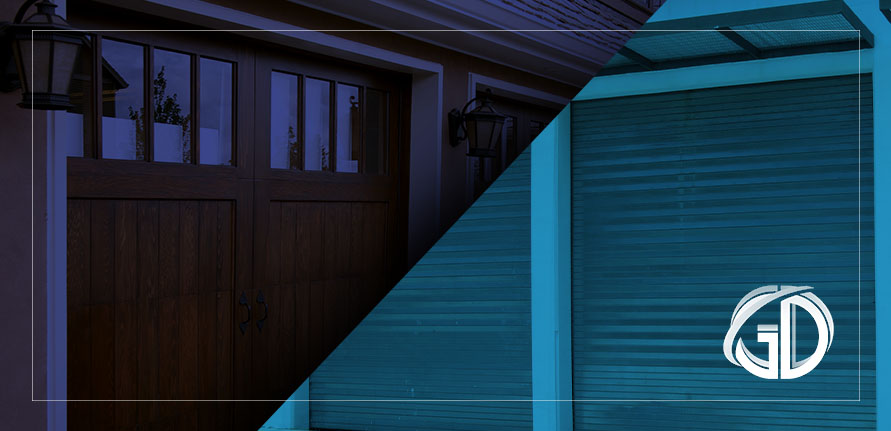
Wood and steel are two of the best materials for a new garage door. They’re long-lasting and stylish and can elevate your home’s exterior. If you’re planning to upgrade your home’s garage door, you might have questions about which material is the right option.
Both choices have pros and cons, but ultimately, the best decision comes down to your personal preferences and priorities. Regardless of which material you choose, upgrading your garage doors can protect your home and increase its curb appeal.
A new garage door is a great investment, and you can enjoy the benefits for years. Use this guide to compare wood vs. steel garage doors so you can make an informed decision.
Pros and Cons of Wood Garage Doors
Many people prefer wooden garage doors because of their high-quality look. They’re beautiful, have a classic style and can elevate your home’s curb appeal. Here are some common pros to choosing a wooden door:
- Traditional style
- Customizable
- Long-lasting
- Insulating properties
- Easy to repair
When you choose a wooden door, the custom options are endless. You can specify window shape and size, panel style, stylistic overlays, hardware and stain color. This product can be designed to complement your home and get the exact look you want.
Wood has low thermal conductivity and does have some natural insulating properties, but is not as insulating as some other materials like steel. When properly maintained, a wooden garage door can last for many years. The longevity of a wood garage door can vary depending on factors such as the type of wood, climate conditions, and proper care and maintenance.
Because they’re such high quality, however, wooden doors do require some upkeep. Here are some of the cons that come with investing in a wooden garage door:
- High comparative cost
- Maintenance needs
- Aging from weather
Wood slightly expands and contracts with changes in weather temperature and humidity. Over time, the finish on wood garage doors may wear off, and you’ll need to reseal them. Because they’re so customizable, wooden garage doors also have a much higher price than steel options.
Depending on your goals, wooden garage doors may be the perfect choice for you.
Pros and Cons of Steel Garage Doors
Steel garage doors have many benefits, but people choose this option mainly for its cost and durability. Here’s a quick list of the top pros for choosing a steel garage door for your home:
- Sleek finish
- Insulation options
- Affordability
- Low maintenance
- Range of colors
- Pattern options
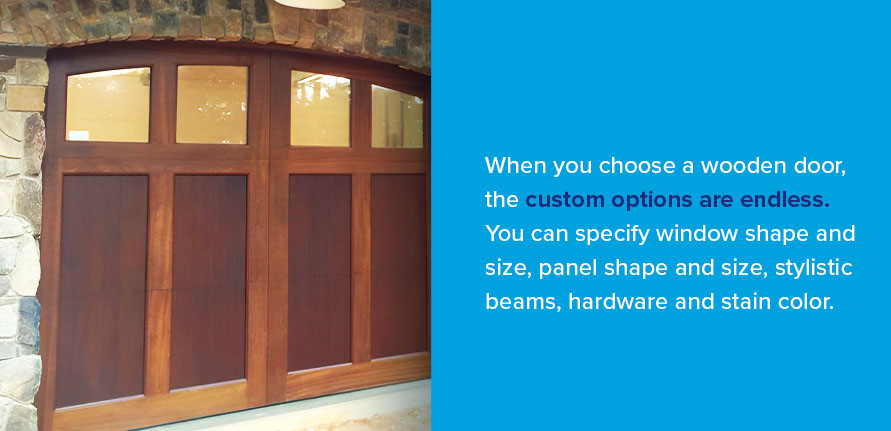
The two winning factors for steel garage doors are their affordability and low maintenance requirements. Steel doors can last a long time with minimal care, and they have a wide range of finish and pattern options.
Some homeowners choose a faux wood overlay so their steel doors have the appearance of a wood finish. This kind of door’s wide range of colors and finishes means you can easily match it to your home and exterior aesthetic.
For all their benefits, however, there are a few cons to selecting a steel garage door. Some of these cons include:
- Low insulation quality (when the door is only one-layer steel)
- Potential for dents
- Possible rust damage
If the finish on your steel doors gets damaged, you’ll need to fix it before rust can set in. Steel might also not be the best option if you have kids who play in your driveway since it does dent. A steel garage door alone can easily conduct cold and heat. Steel garage doors are available with a range of insulation options like polystyrene and polyurethane which can help insulate your garage extremely well.
How to Choose Which Garage Doors Are Best for Your Home
At this point, deciding between metal vs. wood garage doors may be easy for you. However, if you like both options and aren’t sure which one is best, keep reading. We’ll go into a detailed comparison between wood and steel garage doors so you can choose the best option for your home.
Cost
Steel is the best choice if you’d like to buy a garage door on a budget. Steel garage doors can cost less than $1,000, while wood garage doors typically cost several thousand. For a highly customized wood garage door, the total cost could be much higher — $4,000 or more, depending on your location, preferences and the size of your garage. However, custom doors are more expensive for both wood and steel options.
Before deciding against wood garage doors based on cost, talk to a local representative to determine specific pricing for your area. You might also be able to opt for a wood composite that’s more affordable but has the kind of style you prefer.
Style
Which style appeals most to you? Which one would work best with your home? Wood garage doors often work well with traditional houses. You can also consider your home’s exterior and whether a wood garage door would work well with existing decor.
Although many people prefer the look of wood garage doors, steel doors come with a wide range of options and can also elevate your home. Modern homes may be a better fit for steel doors, but they can also be aesthetically pleasing for farmhouse-style homes.
To decide which option would work best with your home’s style, look at examples of different homes. Think about what style your home already promotes and how a new garage door could change or enhance that look.
Maintenance
Both wood and steel garage doors can last for a long time. However, wood garage doors typically take more maintenance — they may need to be resealed several times over the years, and they don’t handle weather changes as well as steel doors.
When you invest in steel garage doors, there’s very little you have to do to maintain them. However, they can be dented with enough force and may develop a rust problem if the finish gets damaged. On the whole, steel garage doors require minimal maintenance.
While part of your investment is financial, another part has to do with time. Long-term maintenance is the responsibility you’re committing to when you purchase a new garage door. Think through how much time you want to spend maintaining this part of your home.
Talk to Garage Door Specialists, Inc. Today!
At Garage Door Specialists, we offer competitive pricing for residential garage doors. Our technicians are trained to repair old garage doors and install new ones.
We carry many Clopay® garage doors, including wood, steel and composite options. Reach out to one of our representatives today for a free estimate or to discuss the best garage door style option for your home. We’re excited to work with you!
How Do New Garage Doors Increase Security for Your Business?
How Do New Garage Doors Increase Security for Your Business?
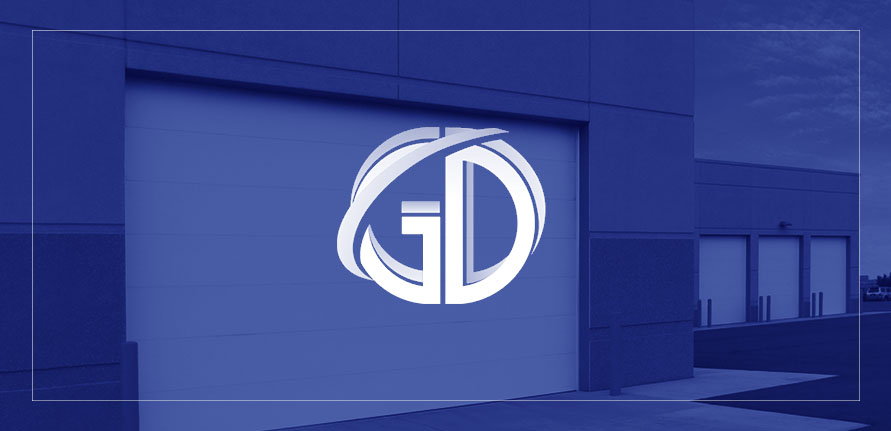
A new garage door can provide a strong, durable defense to help you increase security on your commercial property. New garage doors offer several benefits that make protecting your assets, employees and customers easy, all while streamlining your workflow and boosting your revenue.
Why You Need New Commercial Garage Doors for Your Business
Installing a new garage door on your commercial property allows you to create a safe and comfortable place for your employees and customers, as well as your equipment, inventory and vehicles. New garage doors also offer benefits such as increased productivity, smoother workflows, lower expenses, reduced injury and product damage risks, and boosted property values.
New doors come with features such as:
- Strong, durable and flame-resistant materials that can withstand the weather and frequent use
- Insulation for soundproofing, indoor temperature control and reduced energy expenses
- Attractive appearances that improve customer perceptions, your reputation, your competitive edge and your revenue stream
Other Things You Can Do to Boost Business Security
A few other ways you can increase security on your commercial property include:
- Installing a video surveillance system: Modern surveillance systems allow you to monitor your entire property from anywhere and at any time on your mobile device.
- Improving lighting: Create a secure environment that discourages criminal activity and helps customers and employees feel safe with adequate lighting throughout your commercial property.
- Implementing access control: Access control systems such as keypads, card readers and biometric scanners enable you to better control who enters your commercial space.
How to Boost Garage Door Security
Your garage door helps you safeguard your assets, employees and customers, especially when you choose a strong, durable and reinforced door material. Proper installation will also boost garage door security by ensuring your door can offer long-lasting performance.
Try securing your garage door by:
- Combining traditional and modern security techniques: Supplement traditional locks with access control systems to fortify your security. Connecting your door with smart technology, such as motion detectors and automatic lock systems, can also help increase your door’s security.
- Performing regular maintenance: Keeping your door in good condition is one of the best ways to ensure its longevity and security. Conduct frequent safety inspections to identify and promptly address issues before they escalate into expensive and risky problems.
- Educating employees: Keep your employees up to date about safe operation and maintenance practices so they can help ensure security and safety on your commercial property. The better informed your workforce is, the better you can secure your business.
- Maintaining privacy: You can boost garage door security by using window treatments or frosted glass to minimize sightlines into your commercial space. As you increase privacy, you can enhance security.
Improve Commercial Garage Door Safety With Help From Garage Door Specialists, Inc.
Create a secure commercial space with assistance from Garage Door Specialists, Inc. We can help you find the right door for your security needs. Contact us today to learn more about our commercial garage doors.
10 Tips to Keep Your Garage Cool
10 Tips to Keep Your Garage Cool
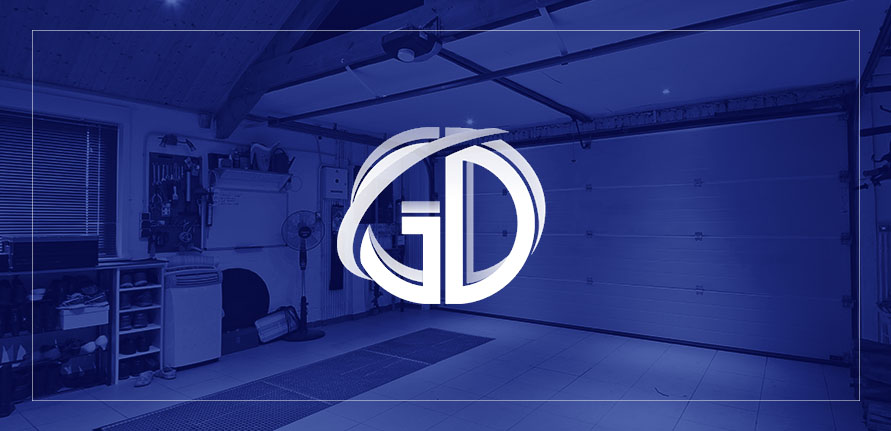
Check out these tips for keeping your garage cool in the summer!
1. Use Your Garage Wisely
Going in and out of your garage all day can trap hot air inside. Try to use your garage in the cooler hours of the day, like early morning. Limiting how often you open and close your door throughout the day can help keep temperatures cool.
2. Park Your Vehicle Outside to Cool Off
An efficient way to cool a garage is to park vehicles in the driveway or a shady spot after using them. Cars can take several hours to cool down, so parking them inside your garage can raise the temperature. Once your car has cooled off, park it inside to keep it secure and protected from outside elements.
3. Open Doors and Windows for Airflow
Open the garage door in the early morning or late evening to let in fresh, cool air. If you have windows, open them too to get a cross breeze that cools your garage. Be sure to close your garage door and windows during the hottest parts of the day. Using window treatments on your windows can also block heat.
4. Place Fans Throughout Your Garage
Installing a ceiling fan is a great way to cool off, as long as your garage is tall enough. Floor fans will work, too. If you have multiple fans, place one at an open door or window to blow hot air out, and set up another directed at you. The fans won’t decrease the temperature, but the flowing air will feel nice.
5. Declutter the Space
Bulky items can block airflow and retain heat. Place equipment, boxes and other large items along walls or on shelves. With these items out of the way, you can improve the efficiency of other cooling methods and better use your space.
6. Try a Dehumidifier
Humidity can make your garage feel hotter than it actually is. Run a dehumidifier with a ventilation system to cool off your garage. A dehumidifier will also help your garage feel less sticky and more comfortable.
7. Set up a Ventilation System
A well-ventilated garage will be a cooler garage. A few garage ventilation ideas include:
- Adding roof vents
- Installing exhaust and ventilation fans
- Using window fans
8. Insulation Ideas
Your garage is exposed to the sun all day, so without proper insulation, heat can penetrate your space. Insulate your garage’s walls and attic to prevent heat transfer and keep the area cool. Upgrade your garage door from a non-insulated door to one with insulation to improve the energy efficiency of your garage.
9. Pick Lighter Colors for Your Garage
Dark colors absorb more heat, so choosing lighter colors for your garage can help it feel cooler. Pay attention to the colors of your roof, exterior walls and garage door. Choose a door with a higher Light Reflective Value (LRV) to help reflect more light and not absorb as much heat.
10. Purchase an Air Conditioner
While it is more expensive than other cooling options, an air conditioner is the best way to cool down a garage. If you plan to spend a lot of time in your garage in the summer, a ductless air conditioner or a portable one may be a valuable investment.
Keep Cool This Summer With Help From Garage Door Specialists, Inc.
Contact us today to see how we can help you pick the right garage door for your home!
Seasonal Garage Door Maintenance Guide
Seasonal Garage Door Maintenance Guide

Year-round maintenance is a must for garage doors because each season presents different challenges. Following the right maintenance routine for the season can keep your door and its components in working order. Follow our seasonal garage door maintenance schedule to know which maintenance and repair tasks to do throughout the year.
Benefits of Regular Garage Door Maintenance
Maintaining a garage door offers several advantages for homeowners. Learning how to maintain a garage door can:
- Save you money since fixing minor repairs is more affordable than a total door replacement.
- Keep your garage door components operational.
- Increase the life span of your garage door and its parts.
- Maintain the structural integrity of your garage.
- Enhance security by preventing access to your home.
- Prevent damage to your vehicle and other belongings.
- Keep you and your family safe from garage door hazards like broken springs.
Garage Door Maintenance Tips by Season
As the seasons change, the way you maintain your garage door should change too. Follow this schedule for garage door maintenance throughout the year.
Spring
After the cold weather, it’s time for spring cleaning — and that should include your garage door. Cleaning your garage door removes the salt, dirt and other debris accumulated over the winter. Wash your garage door with a mild cleaning agent like a detergent or soap. You can clean fiberglass doors with an all-purpose cleaner. Don’t use a pressure washer because it can damage the door surface. Dry the door with a microfiber cloth.
As you’re cleaning the door, take the time to look for damage to the door surface. Steel doors can get rust spots, which you can repair by sanding, priming and painting the area. Wooden doors can warp or have water damage.
Summer
The summer is a great time to check your garage door hardware and the door surface. A summer garage door maintenance routine should involve these areas:
- Garage door structure: Check the garage door for loose or missing parts or rust. Remove the rust and apply a primer to prevent spreading.
- Garage door finish: If your door has peeling paint, take advantage of the pleasant weather to apply a fresh coat of stain or paint. Remove chipped or peeled areas, sand them and apply the stain or paint. Make sure the weather is low humidity with no chance of rain to let the new coat dry properly.
- Hardware: Inspect the door hardware for loose, rusted or missing parts.
- Insulation: Replace damaged or missing insulation immediately to keep the summer heat out of your garage.
- Photo eye: Use a soft cloth to remove debris from the photo eye. Test its function by waving an object in front of the eye while the door is in motion — the garage door should stop immediately.
- Emergency reverse: Test the emergency reverse function by placing an object like a paper towel roll under the garage door. The door should reverse when it reaches the object when trying to close.
Fall
Autumn garage door maintenance focuses on preparing your door for the harsh winter weather. After your summertime inspection, do another inspection in the fall to check these areas:
- Balance: The door’s position should be balanced to prevent excessive wear to the garage door opener. The door may be unbalanced if the door jerks when halfway opened.
- Roller tracks: Lubricate rollers with high-grade spray lubricant and white lithium grease to make the garage door’s motion smooth and reduce tension between the door and rollers.
- Cables and pulleys: The cables and pulleys support the garage door in motion, so inspect them for fraying strands and other damage to keep your garage door operation safe.
- Weatherstripping: The garage door weatherstripping should have no gaps or cracks. Intact weatherstripping keeps your home energy efficient and prevents animals from entering your garage.
- Hardware: Tighten the nuts and bolts on the garage door track to prevent operational issues.
In addition to these areas, inspect the repairs you made in the summer to make sure they’re intact.
Winter
Winter weather can test your garage door’s performance and strength. A thorough maintenance routine during the rest of the year can prevent issues in the winter, like the door getting stuck.
After snowfall, clear the snow and ice away from the door threshold. Ice can make the weatherstripping stick to the garage floor and cause the opener mechanism to have to work harder than normal to open the door, increasing wear and tear.
Common Questions About Garage Door Maintenance
Here are answers to some of the most frequently asked questions about seasonal garage door maintenance:
How Often Do Garage Doors Need Maintenance?
You should have your garage door serviced by a professional at least once a year, even if no issues are present. Preventive maintenance makes your garage door last longer and prevents major operational issues down the road. Your seasonal inspections will help you notice any changes and allow a professional to fix your garage door faster.
Is Do-It-Yourself Garage Door Maintenance Safe?
Some aspects of maintaining your garage door are safe to do on your own, such as repairing rust spots or applying a new coat of paint. However, a professional should handle any concerns with your door’s moving components. Garage door technicians have the tools, parts and experience to make these repairs safely.
Who Can Do Seasonal Garage Door Maintenance?
A garage door repair professional like Garage Door Specialists, Inc. will help you with any installation or maintenance needs. We have provided quality garage door services for the western North Carolina area since 1976.
When you contact us for seasonal maintenance, our professional technicians will bring the appropriate tools and expertise to get the job done. We can easily identify the cause of garage door malfunctions and make the repairs needed right away.
Contact Garage Door Specialists, Inc. to Maintain Your Garage Door Year-Round
Maintain your garage door in any season with the team at Garage Door Specialists, Inc. Our family-owned company offers a variety of garage door services to keep your family safe. Schedule your service with us today to get started!
Garage Door Painting Guide
Garage Door Painting Guide

Your home’s exterior is a canvas for expressing your creativity and style by showing off your favorite colors. Because your garage door is a significant part of your home’s facade, it’s often the first thing someone notices from the outside. Although painting a garage door is a simple way of improving your property’s appearance, there are things to consider before starting a painting project.
Can You Paint a Wood, Vinyl or Metal Garage Door?
If all the components of your garage door are free from damage and functioning correctly, you can paint them, regardless of the material. While some homeowners paint to add a fresh burst of color, others paint their doors when the old coating is scratched, faded or damaged.
However, the factory-applied coating on your garage door will usually last decades with minimal maintenance. Once you paint over the initial layer, you can’t return to those maintenance-free features. Like most exterior coatings, you must usually repaint the surface around every five years.
Preparing to Paint Your Garage Door
Before you begin painting, take these steps.
Choose the Best Paint
While the priming and painting processes are similar, different paint blends exist for various materials. If you’re painting a wood door, choose a primer and paint specifically formulated for wood. The same rule applies to metal doors — oil-based exterior paint is a good choice.
Check the Weather Forecast
Plan to start your project on a cool, dry day. Check the forecast to ensure at least two consecutive days of favorable weather.
Organize Your Tools and Materials
Compiling a checklist ahead of time ensures you have everything you need to complete the job, including:
- Protective gear, like goggles, rubber gloves and dust masks
- Primer and exterior paint
- Rollers and brushes
- Dropcloths
- All-purpose cleaner
- Sponges and shop rags
- A wire brush
- Sandpaper
- Painter’s tape
- A garden hose
- A step stool
Prepare Your Garage Door and Work Area
After putting on your protective gear, use a wire brush to remove rusted or chipped spots and sandpaper to smooth the surface. Look for cracks or dents and repair them with the appropriate metal or wood filler.
Clean the entire surface with a sponge and an all-purpose cleaner and rinse thoroughly. Allow ample time for thorough drying — wood doors may require extra time.
Step-by-Step Processes for Painting Garage Doors
Follow these simple steps to complete your project:
1. Apply Tape
Use painter’s tape to mask off the areas where you don’t want paint, including the trim, windows, handles and locks. In addition, you can protect your garage floor and driveway with drop cloths.
2. Prime the Door
Priming is critical to achieve proper paint adhesion. You can use a roller for the uniform areas, but you may want to use a small brush for the panels and insets. Apply just enough primer to get a thin, uniform coating.
3. Apply the First Coating
Apply the initial coating of paint similar to how you primed the door. Best practices involve beginning with the inner panels and inlays and working outward.
4. Apply Additional Coatings as Needed
After letting your paint dry for at least 12 hours, apply a second coating using the same process. If uneven patches or the old color still shows through, apply additional coats as needed.
Frequently Asked Questions About Garage Door Painting
Some of the most commonly asked questions from our customers about garage door painting include:
What is the best color to paint a garage door?
Homeowners often select a color that complements the rest of their home and property. For the best aesthetics, choose a color with the same cool or warm undertones as your home’s exterior. Explore other combinations around your neighborhood, or check out our residential garage doors for ideas.
Do I need to prime a garage door first?
Priming your garage door allows the paint to adhere to the surface more consistently and evenly, regardless of the material type you’re painting. Priming also helps prevent premature flaking and peeling of the topcoat. In addition, primer is essential if you’re making a drastic color change over your previous color.
How long should I wait between coats of paint on a garage door?
Waiting at least 12 hours between each coat of primer or paint typically produces the best results, ensuring the coating is completely dry to ensure evenness and prevent smearing.
Discover More With Garage Door Specialists, Inc.
Sometimes, a new coat of paint isn’t enough. Whether you need a new garage door style or your current door is in rough shape, Garage Door Specialists, Inc. can help. We have a variety of overhead door styles and colors to suit homes and businesses throughout North Carolina.
To request additional information about our residential or commercial garage doors, contact us online today.
Fiberglass vs. Steel Garage Doors
Fiberglass vs. Steel Garage Doors
Garage doors can make all the difference in the curb appeal of your home or business. On the other hand, an outdated or damaged door can negatively impact the exterior beauty of your property and become a safety risk. Choosing the right garage door is an important task, and it’s a good idea to compare your options before buying, such as a steel vs. a fiberglass garage door.
At Garage Door Specialists, Inc., we carry a wide selection of door styles that are sure to make a statement and provide both style and durability.
Differences Between Fiberglass Garage Doors and Steel Garage Doors
If you’re deciding between a fiberglass or steel garage door, there are a few characteristics you should know about that make these materials different:
- Appearance: Both steel and fiberglass doors can be customized to a certain degree to fit your style preferences and existing structure. Steel is a heavy material that offers a modern, sleek look while fiberglass is a traditional, decorative alternative.
- Composition: Steel garage doors like Modern Steel™ are durable, dependable and very secure, but must be well-maintained to avoid rust. Fiberglass doors like Arbor Grove™ are well-insulated to help reduce noise and are resistant to corrosion.
- Longevity: Made of iron and carbon, steel is incredibly long-lasting and won’t become warped or cracked. Fiberglass material can withstand strong winds and won’t easily dent.
- Cost: The differences in price will depend on the overall design and style options you choose. A fiberglass garage door is a cost-effective, low-maintenance choice that offers more damage resistance, while steel is a budget-friendly, energy-efficient option that keeps your home secure.
Which Type Is Better?
As with any decision for your home or business, the garage door you choose will depend on your personal style, needs, maintenance, budget and many other factors. Both steel and fiberglass have unique benefits and can work for a variety of residential and commercial properties.
You may also make your decision based on the customization options, such as the colors, textures, wood grains, paint, paneling and other design choices. With Garage Door Specialists, Inc., you can find an excellent selection of residential garage doors and commercial overhead doors to complement the exterior of your home or business.
Contact Garage Door Specialists, Inc. for Your Residential and Commercial Overhead Door Needs
No matter what style or material you choose for your garage door, work with a team of experienced professionals to get the job done. At Garage Door Specialists, Inc., we’re committed to fitting your home or commercial building with high-quality and durable garage doors that meet your requirements.
Whether you want to install an entirely new door and hardware or repair your current door, we have everything you need to ensure your product lasts and continues to offer reliable operation. Request an estimate today to get started or contact us online to learn more about the styles and services we offer.
Aluminum vs. Steel Garage Doors
Aluminum vs. Steel Garage Doors
Your garage door is one of the first things people see when they drive up to your home or business. A warped, faded or damaged garage door with rusted or broken parts can pose a safety risk and negatively affect the visual appeal of your property.
If you’re looking for a replacement garage door and wondering what type offers the best performance and longevity, consider an aluminum or steel door from Garage Door Specialists, Inc. We offer custom options for insulation, paint, windows and paneling to fit your unique needs and preferences.
Differences Between Aluminum Garage Doors and Steel Garage Doors
Here’s a comparison of aluminum and steel materials to give you a better idea of these two options:
- Appearance: Steel and aluminum are both popular choices for garage door installations. Both materials can be customized with various panels, finishes and woodgrain designs to suit the look of your home or business.
- Composition: Aluminum garage doors are lightweight, easy to install and corrosion-resistant. At the same time, they may be less effective when it comes to keeping outdoor temperatures outside. Steel doors are heavy, durable and more secure against weather conditions. Both types of doors are made of recyclable, environmentally friendly materials.
- Longevity: Both materials are relatively low maintenance. Aluminum is easy to clean, and you don’t have to worry about rust or rot. Steel garage doors require a pre-painted treatment to prevent rust and corrosion, but they can typically withstand more wear and tear than aluminum.
- Cost: Steel garage doors provide a long-lasting investment at an affordable cost, and aluminum can be even less expensive. While the price of these materials often changes depending on current supply and demand, both options are generally within many budgets.
Which Type Is Better?
As you weigh the pros and cons of steel vs. aluminum doors, it’s important to determine your specific requirements for your new garage door. You may want to consider what kind of design elements you’re looking for as well as identify your ideal price point. You can also weigh whether security is your top priority, or if you’re more concerned with budget and performance.
The team at Garage Door Specialists, Inc. can help you decide between steel and aluminum garage doors to ensure you select the option that best suits your unique requirements.
Let Garage Door Specialists, Inc. Install or Repair Your Garage Door
At Garage Door Specialists, Inc., we know you have many choices when it comes to selecting a new overhead door. That’s why we offer many durable, aesthetically appealing and high-quality residential garage doors and commercial doors so you can find exactly what you’re looking for.
Our knowledgeable, experienced technicians will be glad to discuss your performance and functionality expectations and help you determine the right product and customization options. Contact our team today to learn more about our installation and repair services or request an estimate to get started.


